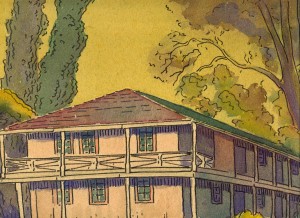Image: (Watercolor by Coastside artist Galen Wolf or one of his students, probably one of his students.)

By June Morrall (I wrote this in 1998)
It’s hard to imagine that Pacifica, a Coastside community of neat neighborhoods, was once a dumping ground for victims of the criminal underworld.
The organized underworld of 1920s Prohibition-era San Francisco consisted of criminals who specialized in bootlegging, gambling, the “white slave trade,” and all the other vices that spilled onto next door neighbor Pacifica.
Isolated and often hidden under a net of fog, the two-story “Old Adobe,” originally the site of a mission outpost in present-day Pacifica, was better known to law enforcement officials as the sleazy “Crime Shack.”
The house was built with sun-dried bricks by Francisco Sanchez, the grantee to the Rancho San Pedro. Sanchez resided in the fine adobe between 1846 and 1862, but 50 years later, surly armed guards were posted around the dilapidated structure, the favorite rendezvous for criminals gathering in Pacifica’s remote Pedro Valley.
Rumor had that the toughest lawbreakers felt safe hiding in the “Crime Shack.” Today, the beautifully restored Sanchez Adobe on Linda Mar Blvd remains an authentic reminder, perhaps the only reminder, of Spanish-American days on the Coastside.
No one knew more about criminal activity at the Crime Shack than Colma Constable S.A. Landini. At the adobe in 1920, Landini led police officers in a shootout with a band of liquor smugglers. On another occasion, the constable arrested members of the Baciagalipi gang for robbing and murdering an elderly man. Landini also broke up a “white slave” vice ring, rescuing four young women from the sinister network.
One woman, a regular at the Crime Shack, told Constable Landini that she could identify San Francisco mob leader Charles Valento as the murderer of her husband. Valento also had been identified as the killer of legendary San Francisco Police Detective Miles Jackson.
A few months earlier, Detective Jackson had been the lead investigator of Dr. Galen Hickok’s “abortion mill,” housed in the famous “castle of mystery” high above Pacifica’s Salada Beach surf. The “castle,” originally built for Ocean Shore Railroad attorney Henry H. McCloskey, grandfather of former Congressman “Pete” McCloskey, still stands overlooking Pacifica’s busy Municipal Fishing Pier.
Three days after testifying for prosecutors in the Hickok trial, held under the dome of the Redwood City Courthouse, Detective Jackson was gunned down by gangster Charles Valento in a brutal shootout in Santa Rosa. Unable to elude the authorities, Valento was captured and jailed.
Revenge for Detective Jackson’s death came swiftly. In Wild West vigilante style, a party of 100 masked men in 15 automobiles burst into the Santa Rosa jail, seized Valento and two other gang members, hanging all three on a tree overlooking the Odd Fellows cemetery.
Constable Landini, who had assisted Jackson with the Hickok case, was deeply familiar with Pacifica’s terrain. He knew every hidden valley and cow path; he knew every bend and turn of twisty Pedro Mountain Road. These skills proved invaluable later when the constable led a manhunt in Pacifica for Colma priest, the Reverend Patrick E. Heslin, abducted from his parish house in the summer of 1921.
On food and horseback, Landini and his men fanned out from Colma, heading south toward Pedro Mountain Road. The manhunt was meticulous. After threading through the mass of scrub and thick underbrush high on the side of the mountain, the posse approached a “squalid shack” at the end of a narrow foot trail. Near the shack stood two horses, saddled, with a rifle holster hanging from each saddle. A search of the shack came up empty; the riders of the horses were nowhere to be found, nor was there a trace of Father Heslin.
Constable Landini picked up the scent of Father Heslin’s abductor while interviewing a Salada Beach restaurant owner. Landini had a description of the kidnapper, and the restaurateur confirmed seeing the man, his clothes, gritty with sand.
The clue led Landini to Father Heslin’s shallow grave located beneath a Salada Beach billboard advertising a pancake mix.
Charged with murder in the first degree was William A. Hightower, a cook and former manual laborer for the Ocean Shore Railroad. In a sensational trial held at the Redwood City courthouse, Hightower was found guilty and sentenced to life in prison. At the time of Hightower’s trial, there were unconfirmed reports that he had ties to the underworld of Sacramento.
Five years later, when the body of a young woman, wrapped in a sheet, was found in “O’Malley’s Gulch” near Salada Beach, police confirmed that the victim was the “Moth Girl,” part of San Francisco’s underworld. A police search of the “Moth Girl’s” apartment–where the last recording she played on her portable Victrola was the jazz favorite, “Charleston”–led investigators to believe she led a double life: one as a conscientious piano student, the other as a player in the city’s dangerous night life. Continue reading “Sanchez Adobe Was Once Pacifica’s “Crime Shack””
